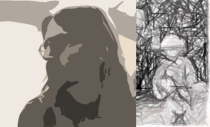The email sent will contain a link to this article, the article title, and an article excerpt (if available). For security reasons, your IP address will also be included in the sent email.
In the matter of making moral judgments we must somehow get to the point of recognizing the other as like ourselves. Of course this is not unique to human beings. Dogs do it. Cats do it. Apes do it. Even the birds and the bees do it. The issue is not this sub-rational recognition which all these creatures have and which we possess in common with them, however. We know others at a basic level by their appearance and behavior. But the issue isn't that but, rather, when and how it becomes a part of our deliberative consciousness, the one that thinks ABOUT things and stuff.
Those other creatures don't seem to have this capacity (to think about things though they certainly can remember and react). To think about something we need the capacity to turn our sensory inputs into a world, to make it more than just our immediate impinging environment so that it becomes part of an extended domain in time and space, with a past and a future and a here and a there. China exists for us but not for these other animals even if they share our world, as known by us, with us. It is language capability that enables us to frame our inputs as a world and to relate to its many parts in a valuing way. The world we observe is horizontally existent, the things in it vertically existent on an imaginary vector between each of these and us.

 (Stuart W. Mirsky is the principal author of this blog).
(Stuart W. Mirsky is the principal author of this blog).




 Return to Article
Return to Article